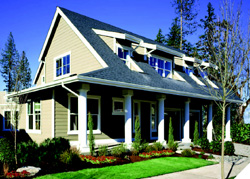“… A green building product is not going to make a difference if it’s not installed properly,” Pfieffer explained. He emphasized not only proper installation, but also thoughtful site planning and house design that take location and climate into consideration, as well as the lifestyle of the homeowners. For example, design lots so that most of the home’s windows are facing south and north, utilize overhangs, make homes at a minimum solar-ready, air out carpeting, use light-colored roofs, and keep bedrooms on the second floor to help save energy and create a buffer.
Product knowledge and building science know-how also are key for dealers looking to supply green builders. “[Dealers] should be the repository of knowledge more so than the builder,” says Dennis McConnell, president of Atlanta-based McConnell Homes, which builds custom homes to the standards of three green building programs, including an EarthCraft home on the conference tour. McConnell says dealers should understand the mechanics and physics of the products they sell, including how they work together and installation requirements.
Catch the Wave Dealers armed with knowledge may also be able to play an important role in marketing the trend. Though the buzz is strong for green building and consumer interest is growing, sustainable homes have to offer more than just a warm-fuzzy feeling in order to get buy-in from builders and buyers. McConnell says one way of doing this is building homes that have more demonstrable value than just being green, such as being a low-allergen home or earning credits from a utility company. Communicating the multiple benefits of green-labeled products are one way dealers can help in this effort.
Interested dealers also may want to consider becoming involved with local green building programs. According to the NAHB, there are 30-plus green building programs run by HBAs and other entities around the country. The NAHB recently introduced its Model Green Home Building Guidelines, which are designed as a tool for builders incorporating sustainable practices into their houses and for local HBAs developing their own programs.
Demonstration homes are another way of raising awareness and may provide another avenue for dealers to get involved. “Sustainable marketing” was the mission behind the Puget Sound Energy Built Green Idea Home at Issaquah Highlands near Seattle, says Bruce Woodstrom of Fusionpartners, which helped coordinate and market the home. When developer Port Blakely Communities began requiring builders at Issaquah Highlands to build to the standards of Built Green (the sustainable building program in the Seattle area), it decided to build a demonstration home to show builders and consumers the practical approach to Built Green. Woodstrom reports that the house, which was designed by Mithun and built by Bennett Homes, received enormous buzz and support around the region and sold at full price. “[It’s] a testament that when Built Green is sold properly and demonstrated properly it will enhance sales,” he says.
As Built Green and other programs around the county prove, there’s no question that interest in green building is growing. And as resources become more scarce, indoor air quality concerns grow, and foreign oil dependence takes center stage in politics, consumer attention toward and demand for sustainable building should continue to swell. Now is the time to get involved and start serving early adopters by providing the products and the product knowledge to help customers build better, more sustainable homes.



